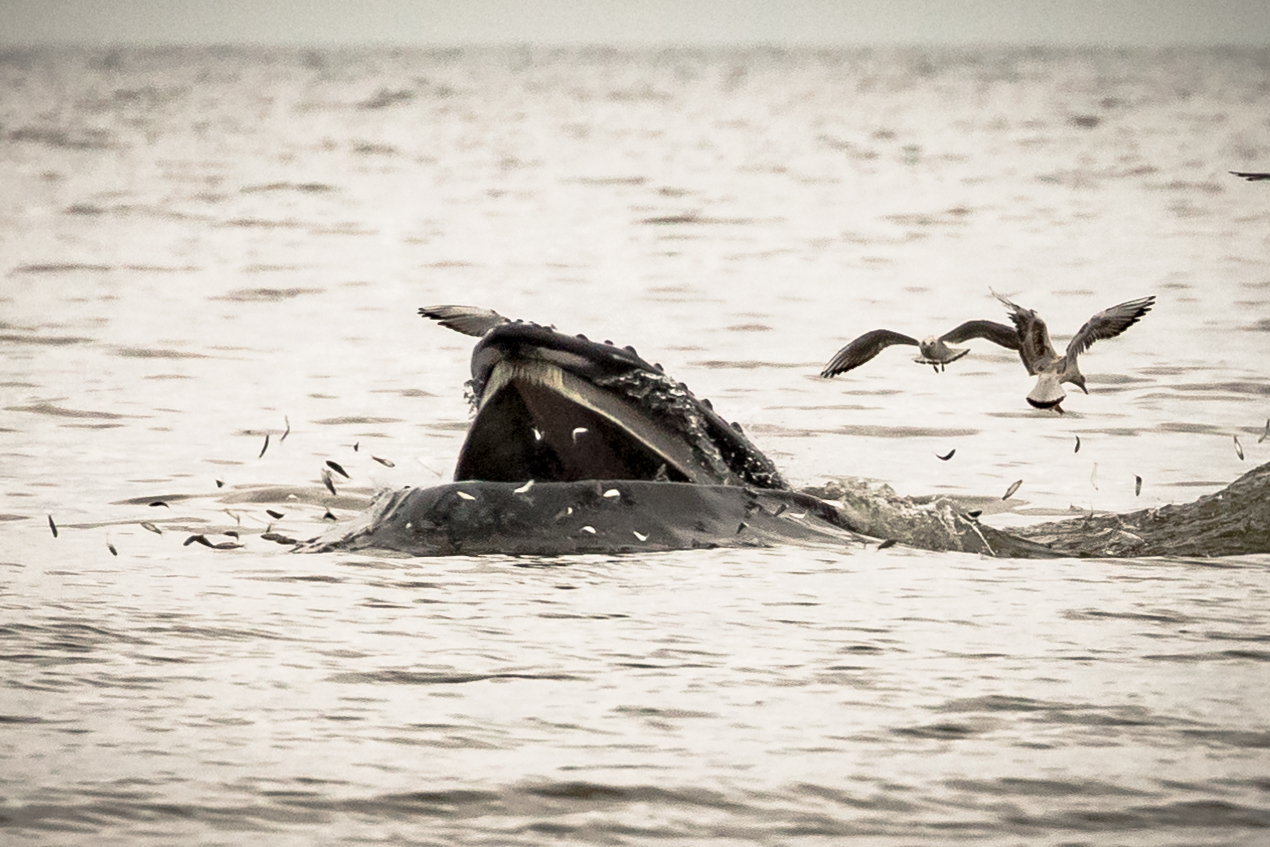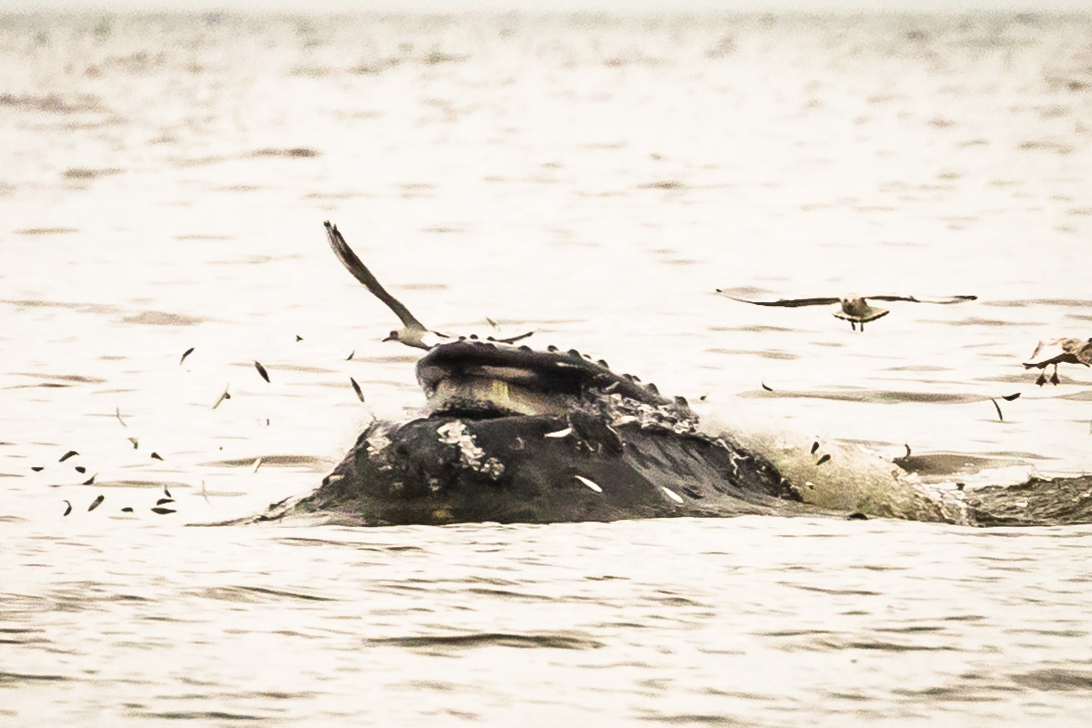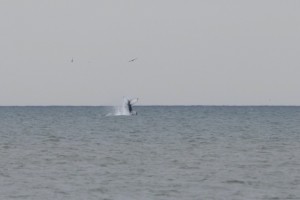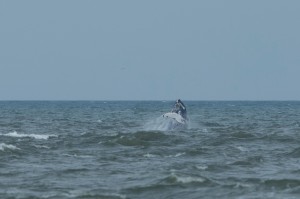The National Whale and Dolphin Watch took place at the end of July with around 500 sightings reported so far.
One of these sightings that has captured people’s imagination was of a majestic humpback whale off the coast of Aberdeenshire. News of the whale first came to Sea Watch on Saturday 30th July when Eilidh Watson posted her incredible photographs of the animal on the NE Scotland Wildlife Facebook group, followed by Sea Watch’s Sightings Officer, Kathy James.
 The humpback whale photographed off Newburgh. Photo by Eilidh Watson.
The humpback whale photographed off Newburgh. Photo by Eilidh Watson.
“We have been receiving reports of incredible whale, dolphin and porpoise sightings throughout the National Whale and Dolphin Watch, but when I browsed Facebook on Saturday evening I was thrilled to see such amazing photographs of a humpback whale, and taken from the shore too!” says Kathy.
The whale has in fact been in the area since 24th July, and daily reports are still coming in to the national research charity.
 The Newburgh whale has been seen feeding close to shore. Photo by Eilidh Watson.
The Newburgh whale has been seen feeding close to shore. Photo by Eilidh Watson.
“It’s really important that people report their sightings of this whale and any other sightings that they may have around the Scottish coast because it enables us to provide data on their abundance and distribution” continues Kathy.
Throughout the National Whale and Dolphin Watch, humpback whales were seen elsewhere in Scotland, in the Moray Firth in the east and off Stoer Head Lighthouse in the west. The same animal photographed off Newburgh may have been the one also seen off Collieston, Aberdeenshire by Sea Watch Foundation’s Grampian Regional Coordinator, Kevin Hepworth, during one of his watches.
Humpback whales are not common in British waters, but are increasingly being encountered particularly off the west coast of Ireland and in northern Scotland in summer, on their way between summer northern feeding grounds around Iceland and northern Norway and winter breeding grounds off the coasts of NW Africa. For half a century, the species was extremely rare in British waters after a long history of over-exploitation. However, since the 1980’s, the species has been recorded regularly from Shetland, the northern Irish Sea, and in the western approaches to the Channel.
Figure 1: Humpback whale sightings around Scotland in 2015
Humpback whales are individually identifiable by their distinctive pattern on their tail flukes as well by the dorsal fin shape. Comparing photographs of the Moray Firth individual seen on the 25th to the animal widely seen off Newburgh, it would appear that they are in fact separate animals, meaning at least three different humpback whales were present in Scottish waters towards the end of July.
A humpback whale fluke can be used to identify individuals. Photo by Alan Airey/ Sea Watch Foundation on Hebridean Whale Cruises earlier this summer
“The recent appearance of a humpback whale close to the shores of the East Grampian coast at Newburgh has provided a great deal of pleasure to many enthusiastic onlookers. Video and still photos have shown this great whale to be feeding actively. Indeed, the majority of sightings of humpbacks in British coastal waters have been associated with large shoals of fish such as herring and sprat. This particular animal may be no exception since herring stocks have started to recover, attracting aggregations of feeding seabirds as well as a variety of cetacean species from humpbacks and minke whales to orcas and white-beaked dolphins. This coupled with the long-term recovery of humpback whales following the cessation of whaling of the species some 50 years ago, probably accounts for the increase in sightings of humpbacks around the British Isles in recent years.” adds Peter Evans, Founder and Director of Sea Watch Foundation.
Whilst an increase in humpback whale sightings is welcomed by the charity, they do raise concerns about the future of these animals off our coasts. “Unfortunately, whilst we are thrilled to have this magnificent and acrobatic species increasingly visiting our coasts, we fear for its future here since, far too often, instances are reported to us of fatal entanglement of humpbacks and other large whales such as minkes in creel lines and discarded fishing gear.”
This accidental by-catch may pose the biggest threat to these enigmatic species and should be addressed by all sectors to see them thrive into the future.
Acrobatic images of the Newburgh whale taken on 31st July (left) and 2nd August (right).
Photos by David Jefferson/ Sea Watch Foundation.
Further sightings during the National Whale & Dolphin Watch event included large numbers of killer whales around Shetland, where up to 25 were seen on various occasions. Five killer whales were also spotted off the Aberdeenshire coast on the 26th, and others were present around the Hebrides early on in the watch. Bottlenose dolphins put in appearances all along the eastern shores of Scotland, while Risso’s dolphins were spotted off Ullapool on the 28th. Minke whales and harbour porpoise showed all around the country throughout the period.
Observers are encouraged to continue to send in their sightings from the National Whale & Dolphin Watch period (23rd-31st July) to add to the tally. Sea Watch Foundation welcome records of sightings of whales, dolphins and porpoises throughout the year and people are advised to get in touch if they’d like to become a volunteer surveyor with the charity.
See the National Whale & Dolphin Watch results so far: www.seawatchfoundation.org.uk/nwdw-2016
Report sightings: www.seawatchfoundation.org.uk/sightingsform
Become a regular volunteer: www.seawatchfoundation.org.uk/become-a-sea-watch-observer




























